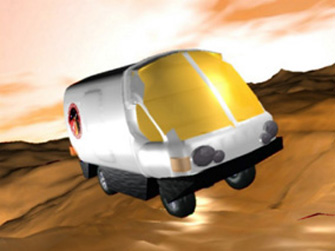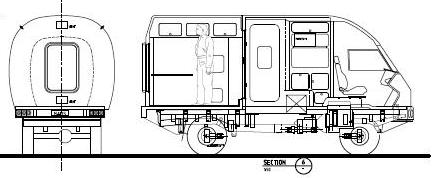Main menu
Starchaser Marsupial Rover

Marsupial Rover
Mars has a surface area roughly equivalent to that of all the earth's continents combined. Humans will be sent to Mars to explore, to undertake scientific research and to locate resources. This will require the ability to safely travel long distances across the surface, for which they will need rugged, self-contained, all terrain vehicles. The requirements of Martian rovers will differ from those used in the lunar landings in a number of ways. They will need to be capable of undertaking long overland journeys, contain pressurised living quarters and be robust enough to operate for periods of years.
What is an optimal crew size for such a vehicle? How much internal space within the vehicle needs to be pressurised? How small can a vehicle be to undertake long distance traverses of +200km? What are the optimal exploration strategies? To date, little research has been undertaken into such issues.
Mars Society Rover Initiative
In 2000 the international Mars Society Rover Initiative (MSRI) provided three teams with seed funding to commence design and construction of working Mars pressurised rover simulation platforms, which could be used to investigate these kinds of questions. Two teams were from North America, the other was from the Mars Society Australia (MSA).
The vehicles were to be constructed to undertake human factors research. For this purpose, they were not required to be entirely custom made structures with the exact engineering tolerances and sophisticated internal life support systems a real Mars rover would require. (They were to be built on the chassis of commercially produced road vehicles and run on standard petrol engines.) Instead, they were to realistically simulate the spatial and operational characteristics of such vehicles, with air locks, work, living and storage spaces.
Both the Michigan Everest and Canadian Ares rovers were built and trialed in carefully planned, simulated cross-country expeditions, which tested the effectiveness of each design configuration in different mission scenarios. Testing notably includes a series of comparative field missions undertaken in 2003 on the Australian-Canadian Expedition 1 at the Mars Desert Research Station in Utah.
Project Marsupial
Marsupial cross-section view
The Australian analogue rover project, the Starchaser Marsupial Rover was formulated with a longer term vision to develop a family of such rovers and provide Australians which could contribute to the design database for future real Mars rover vehicles.
The vehicle is based on the chassis of a Forward Control Landrover. The FC Landrover has a distinguished history as a rugged 4WD military truck, emergency ambulance, expedition and safari transport. The purchased vehicle is a Series IIA, similar to the one in the photo. It will require some repair work before being ready to drive. We intend the Marsupial rover to be driveable on public roads, since this will greatly enhance its useability.
Having published the results of his pioneering comparative studies of the North American rovers on Expedition 1 in prestigous journals including the Journal of the British Interplanetary Society, Dr Graham Mann, the initial Project Manager for the Starchaser Marsupial, is keen to undertake a similar series of trials with the Australian rover (to be known as Marsupial Trax) once its construction is complete.
Now in Adelaide, South Australia, for the next stage of development, and where it is envisaged the vehicle will be based, Marcia Tanner has taken over the role of Project Manager.
Further Reading
Clark, Benton, "Mars Rover", in Carol R. Stoker and Carter Emmart (eds.), Strategies for Mars: A Guide to Human Exploration, Science and Technology Series, 1996, pp. 445-63.


